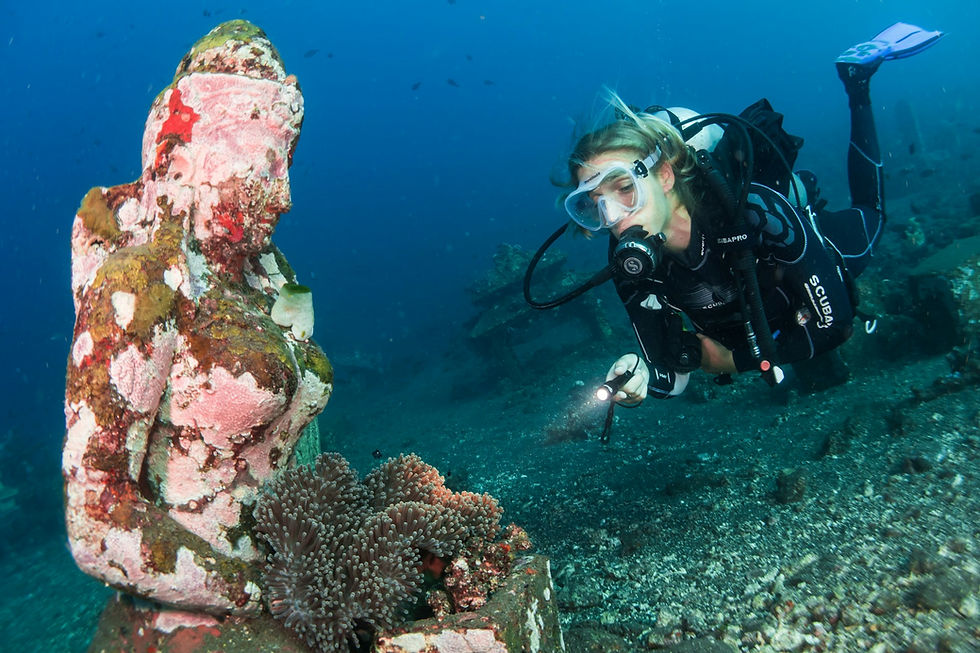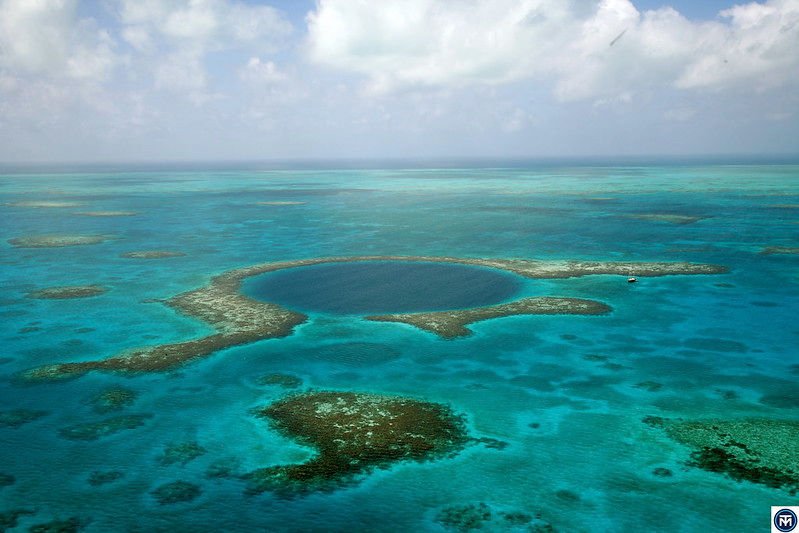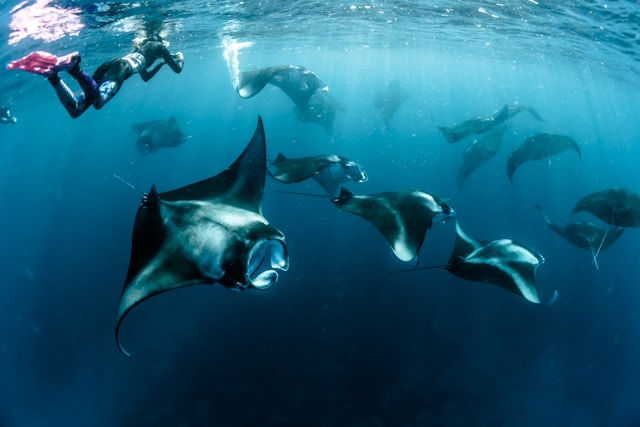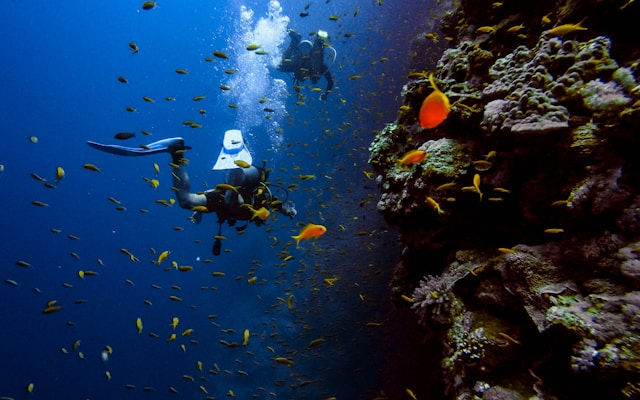This places is among the best in the world for scuba diving
- Paul Aage Hegvik

- Mar 14
- 15 min read
For divers eager to explore the world's most vibrant underwater ecosystems, these five destinations stand out for their rich marine life and crystal-clear waters.

From the Great Barrier Reef’s massive coral formations to the Galápagos Islands’ unique species, each location offers unparalleled diving experiences. Whether you’re diving with manta rays in the Maldives or exploring ancient shipwrecks in Belize, these top spots provide a true glimpse into the wonders of the deep

Great Barrier Reef, Australia
Location: Northeastern coast of Queensland, Australia. How to get there: Fly into Cairns or Port Douglas airports, then take a boat to the reef. Brief history: The Great Barrier Reef is the largest living structure on Earth, stretching over 2,300 kilometers. It is over 25 million years old and was designated as a UNESCO World Heritage site in 1981. The reef is home to an extensive ecosystem, with more than 1,500 species of fish and 400 types of coral.
What to see:
Vibrant coral gardens
Manta rays, turtles, and sharks
Over 1,500 species of fish
Shipwrecks like the SS Yongala (accessible via dive tours)
Tropical fish swarming around the reef formations
Equipment rental prices: Around $35–70 per day for scuba gear.
Guided tour with boats: Day trips range from $100–200, with specialized boat
tours available for diving.
PADI courses for beginners: Open Water Diver course from $350.
Attractions
Snorkeling at Green Island – A popular snorkeling spot where you can view abundant marine life. Diving at Cod Hole – Famous for close encounters with large potato cod.
Exploring the Ribbon Reefs – A chain of reefs offering diverse underwater experiences.
Visiting the Daintree Rainforest – The world's oldest tropical rainforest, located nearby.
Watching – Between June and November, you can see humpback whales.
Accommodations
Cairns Plaza Hotel – Central location, pool, from $70 per night.
Port Douglas Motel – Budget-friendly, close to the beach, from $60 per night.
Reef Palms – Self-contained units, family-friendly, from $80 per night.
Gilligan's Backpackers Hotel & Resort – Social atmosphere, from $25 per night.
Abbott Boutique Hotel – Historic charm, city center, from $90 per night.
Restaurants
Ochre Restaurant – Modern Australian cuisine, with a focus on local ingredients.
The Raw Prawn – A well-loved seafood restaurant offering fresh fish and lobster.
Café de Paris – French-inspired dishes served in a cozy setting.
Salt House – Waterfront dining with stunning views and fresh seafood.
Prawn Star – A seafood boat that serves local catches, perfect for casual dining.

Raja Ampat, Indonesia
Location: West Papua province, Indonesia.
How to get there: Fly to Sorong via Jakarta or Makassar, then take a boat to the islands.
Brief history: Raja Ampat is known for its extraordinary marine biodiversity, considered one of the world's best dive destinations. The area is relatively untouched, and its reefs remain in pristine condition. The islands were only explored by the global diving community in the late 1990s, despite being known to local Papuans for centuries.
What to See:
Over 1,500 fish species, 600 types of coral, and thousands of marine species
Manta rays, sharks, and schools of barracuda
Seafloor biodiversity including sea slugs and pygmy seahorses
Rich marine life on underwater pinnacles like Blue Magic
Vibrant coral gardens and caves
Equipment rental prices: Around $30–60 per day for dive gear.
Guided tour with boats: Liveaboard trips range from $600–1,200 for a 3-day
tour.
PADI courses for beginners: Open Water Diver courses typically cost around $350.
Attractions
Diving at Cape Kri – Known for the highest recorded number of species spotted in a single dive.
Snorkeling at Manta Sandy – A popular spot for swimming with manta rays.
Exploring Wayag Island – Famous for its beautiful lagoons and karst rock formations.
Birdwatching for Wilson's Bird-of-Paradise – A rare bird species endemic to the islands.
Traditional Village Visits – Learn about local Papuan culture through village tours.
Accommodations
Raja Ampat Dive Lodge – Beachfront, $100 per night.
Kri Eco Resort – Eco-friendly, from $150 per night.
Misool Eco Resort – Luxury resort, all-inclusive, $400 per night.
Sorido Bay Resort – All-inclusive, $200 per night.
Raja Ampat Biodiversity Resort – Budget-friendly, $50 per night.
Restaurants
Kri Eco Resort Restaurant – Serves Indonesian and international dishes.
Misool Eco Resort Dining – Focuses on fresh seafood and local flavors.
Raja Ampat Dive Lodge Restaurant – Serves a variety of meals, emphasizing local ingredients.
Warung Makan Sate – Local Indonesian food with a focus on grilled meats.
Kampung Sagu Restaurant – Traditional Papuan cuisine served in a rustic setting.

Blue Hole, Belize
Location: Off the coast of Belize, near Lighthouse Reef. How to get there: Fly to Belize City, then take a boat to the Blue Hole. Brief History: The Blue Hole is a massive marine sinkhole that was formed thousands of years ago. It became famous after Jacques Cousteau's exploration in 1971, which brought global attention to its underwater beauty. It's considered one of the top diving spots due to its clear waters, coral formations, and abundant marine life.
What to See:
Stalactites and stalagmites in the deeper regions
The famous underwater «drop-off»
Sharks, especially the Caribbean reef sharks
Vibrant corals and schools of tropical fish
The Blue Hole’s surreal, deep blue waters
Equipment rental prices: Around $40–75 per day for dive gear.
Guided tour with boats: Day trips cost around $250–350.
PADI courses for beginners: Open Water Diver course starts around $400.
Attractions
Diving at the Blue Hole – The highlight of any trip, offering incredible underwater visibility and unique formations.
Shark Ray Alley – A must-see for those interested in seeing nurse sharks and stingrays up close.
Hol Chan Marine Reserve – A protected area with abundant coral reefs and marine life.
Lighthouse Reef – Known for its deep waters and coral atolls
Ambergris Caye – A nearby island with stunning beaches and snorkeling opportunities.
Accommodations
Belizean Shores Resort – Affordable beachfront accommodations, from $120 per night.
Sunbreeze Suites – Situated on Ambergris Caye, from $135 per night.
The Phoenix Resort – Luxury resort with full amenities, from $200 per night.
Hotel de la Fuente – Budget-friendly, $60 per night.
Coco Beach Resort – Beautiful beachfront property, from $160 per night.
Restaurants
The Blue Water Grill – Seafood and grilled meats with a beachfront view.
Wild Mango's – Caribbean and international dishes.
Elvi’s Kitchen – Traditional Belizean food in a relaxed atmosphere.
Café Amigo – A casual dining spot serving delicious Tex-Mex dishes.
Palapa Bar and Grill – Known for its laid-back vibe and seafood options.
Galápagos Islands, Ecuador
Location: Pacific Ocean, approximately 600 miles west of mainland Ecuador.
How to get there: Fly into Baltra Island via Quito or Guayaquil, then take a boat to your dive destination.
Brief history: The Galápagos Islands are a volcanic archipelago known for their exceptional biodiversity. The islands gained scientific importance after Charles Darwin's visit in 1835, which influenced his theory of evolution. They became a UNESCO World Heritage site in 1978, attracting scientists, conservationists, and divers.
What to See:
Marine iguanas and sea lions
Hammerhead sharks, whale sharks, and Galápagos sharks
Colorful marine life and clear blue waters
Lava tunnels and volcanic formations
Birds like the blue-footed boobies and frigatebirds
Equipment rental prices: Around $40–80 per day for dive gear.
Guided tour with boats: Liveaboard dive trips range from $1,200–2,500 for a week.
PADI courses for beginners: Open Water Diver course typically costs $400–500.
Attractions
Wolf and Darwin Islands – The top spots for hammerhead sharks and large marine species.
Devil's Crown – A submerged volcanic caldera rich in marine life, often visited for snorkeling and diving.
Kicker Rock – A stunning rock formation known for diving with sea lions and turtles.
Gardner Bay – Ideal for diving with rays, sea lions, and numerous fish species.
The Charles Darwin Research Station – Learn about conservation efforts for endemic species.
Accommodations
Finch Bay Eco Hotel – Luxurious beachfront property, from $200 per night.
Hotel Pelican Bay – A more budget-friendly option, from $95 per night.
Galápagos Safari Camp – Luxury tented camp experience, from $350 per night.
Red Mangrove – Dive-centric hotel offering packages, from $150 per night.
Hostal Galápagos Verde Azul – Budget-friendly, family-run, from $50 per night.
Restaurants
Isla Grill – Fresh seafood with a view of the harbor.
The Rock Restaurant – Serves a variety of international and Ecuadorian dishes.
La Garrapata – Traditional Ecuadorian food and great seafood options.
El Cafe de la Sede – Local coffee shop offering light bites and local delicacies.
Café San Sebastián – Casual, offering pizza and hearty meals with an island twist.

Maldives
Location: Indian Ocean, southwest of Sri Lanka.
How to get there: Fly into Malé International Airport, then take a domestic flight or speedboat to your resort or diving spot.
Brief history: The Maldives is a tropical paradise made up of 26 atolls and over 1,000 islands, known for its coral reefs and crystal-clear waters. With a history dating back over 2,000 years, the Maldives has been influenced by Indian, Arab, and European cultures. The islands gained prominence as a luxury travel destination in the 1980s.
What to see:
Manta rays and whale sharks
Vibrant coral reefs and abundant marine life
Underwater caves and wrecks
The famous «Glow-in-the-Dark» plankton at some resorts
Sea turtles and eagle rays
Equipment rental prices: Around $30–60 per day for scuba gear.
Guided tour with boats: Guided dive tours typically range from $100–250.
PADI courses for beginners: Open Water Diver courses start around $400–450.
Attractions
Diving at Maaya Thila – A world-famous dive site for reef sharks and pelagic fish.
Snorkeling with Manta Rays at Hanifaru Bay – Known for manta ray aggregation.
Exploring the Baa Atoll – An UNESCO biosphere reserve teeming with marine life.
Banana Reef – The first dive site in the Maldives, rich with marine diversity.
Submarine Ride in Malé – A unique underwater experience for those who don’t dive.
Accommodations
Soneva Fushi – Exclusive resort with dive facilities, from $1,000 per night.
Kurumba Maldives – Luxury resort with dive offerings, from $250 per night.
Embudu Village – Budget-friendly option, from $120 per night.
Gili Lankanfushi – An eco-luxury resort, from $600 per night.
Maafushivaru Maldives – Boutique resort, from $350 per night.
Restaurants
Ithaa Undersea Restaurant – Dining below sea level, offering seafood and local specialties.
Fushi Café – Offering casual dining and Maldivian specialties.
Reef Restaurant – Overwater dining experience with local seafood delicacies.
Thila Restaurant – Traditional Maldivian dishes served in a chic setting.
What is PADI?

PADI (Professional Association of Diving Instructors) is the world’s largest and most recognized scuba diving training organization.
Established in 1966, PADI sets the global standard for recreational diving education. It offers a wide range of courses, from beginner to professional levels, and is recognized globally by dive shops, instructors, and operators.
PADI focuses on safety, environmental responsibility, and high-quality diver education. Whether you are just starting or looking to enhance your skills, PADI provides training tailored to all experience levels.
Key aspects of PADI
Learn to dive in open water The entry-level course, Open Water Diver, teaches the basic skills needed for recreational diving. Advanced courses build on these fundamentals with specialty dives like wreck or deep diving.
Get globally recognized certification PADI certifications are accepted in over 180 countries, making it easy for you to dive anywhere in the world with confidence.
Join efforts in marine conservation PADI encourages divers to engage in environmental initiatives and follow responsible diving practices to protect marine ecosystems.
Learn theory online PADI’s e-learning platform allows you to study the theoretical part of the course at your convenience before starting practical sessions.
How to get certified
Find a PADI dive shop Search for a PADI-certified center or instructor near you or at your travel destination.
Start with the right course Beginners should enroll in the Open Water Diver course, while experienced divers can choose advanced or specialty certifications.
Practice in confined water Begin your training in a safe and controlled environment like a pool, where you’ll learn essential skills.
Dive in open water After mastering the basics, head to the ocean or a lake to complete your training dives under the supervision of an instructor.
Receive your certification After meeting all requirements, you’ll earn your PADI certification, enabling you to explore underwater worlds across the globe.
PADI certifications are highly respected in the diving community, giving you the skills and confidence to safely explore the wonders of the underwater world.
Tips for your first scuba dive trip

Here are some essential tips for your scuba diving journey, along with key guidelines you’ll encounter when you earn your diving certification.
Ensure you are certified for diving before you travel, or sign up for a course during your vacation. Most dive operators worldwide require at least the PADI Open Water Diver certification. An operator who doesn’t ask for certification is likely not serious—stay away from unprofessional ones! Make sure the dive school/instructor is well-established with good qualifications. Also, verify that the equipment and boats are regularly maintained.
Medical certification
See own article
Emergency preparedness
Carry your insurance number, medical information, and emergency contacts with you. Keep these details handy in case of an emergency.
Double-check your gear
Before heading to the dive site, ensure you set up all your diving equipment properly. Take your time and check that everything works. It's a good idea to also check with your dive buddy, making sure all equipment is in working order. If you’re unsure of anything, don’t hesitate to ask your guide or instructor for help.
Listen to your instructor/guide
It’s essential to listen to your instructor or guide when you are at the dive site, no matter how experienced you are. The most important rule in diving preparation is «Plan Your Dive, Dive Your Plan.»
Never hold your breath
Scuba diving is an exciting and unique experience, as you're breathing underwater. However, it is crucial never to hold your breath. Always breathe normally during the dive. Holding your breath can cause an air embolism, which occurs when air bubbles enter your bloodstream and can lead to serious injury or even death. Stay relaxed and avoid swimming too fast, as this can make you out of breath. Signal to your dive buddy if you're feeling tired and find a stable spot to rest, like a rock or ledge.
Protect coral reefs
To protect coral reefs, never touch them. Many corals are sharp, marine plants can be toxic, and some creatures may bite if they feel threatened. Respect the underwater environment to keep it intact for future generations.
Avoid diving alone
Don’t be tempted to swim alone when you spot something interesting. Point it out to your guide and stick with your dive buddy. If you lose sight of each other underwater, take a minute to look around. If you still can’t find them, ascend slowly to the surface to meet up with your partner.
Check your air supply
You can only stay underwater as long as you have air in your tank. Be aware of when your tank is half or a quarter full, so you can plan to return to the surface in good time. Your guide will check your air level regularly, but ultimately, you are responsible for monitoring your air consumption.
Ascend slowly
In addition to not holding your breath, the second most important rule in diving is to ascend slowly. Rapid ascents can cause decompression sickness (the bends), as nitrogen bubbles may form in your bloodstream when you rise too quickly.
Maintain your yquipment
After your dive, avoid leaving your equipment in a pile on the boat deck. This is not only bad for the equipment but can also pose a safety risk to you and others who might trip over it. Diving equipment is heavy and can be dangerous if not handled and stored properly.
Feeling unwell? Speak up!
If you’re feeling unwell after a dive, don’t keep it to yourself. Let others know. Many divers feel tired simply because they aren’t used to the physical exertion of diving. If you feel anything unusual, speak up and tell your guide.
Wait 24 hours before flying
Because your body absorbs a significant amount of nitrogen while diving, it's essential not to fly for at least 24 hours after your last dive. Flying in a pressurized environment before this period could result in decompression sickness as the nitrogen hasn't had time to dissipate from your body.
Additional tips
Stay hydrated: Diving can be physically demanding, so make sure to drink plenty of water before and after your dive to stay hydrated.
Protect your Skin: Underwater sun exposure can be intense, so use reef-safe sunscreen before your dive.
Respect marine Life: Observe marine creatures from a safe distance without disturbing their natural behavior.
Know your limits: If you're feeling fatigued or uncomfortable, it's okay to cut a dive short. Your safety is the priority.
Use the Buddy system: Always dive with a buddy for safety. This ensures there’s someone to assist in case of an emergency.
By following these tips and guidelines, you can ensure a safe and enjoyable diving experience, whether you’re just starting your diving journey or looking to refine your skills.
Medical certification for scuba diving

Before you start scuba diving, it’s important to make sure you’re in good health to safely participate in this physically demanding and exciting activity.
Most dive operators and schools require a medical certification to confirm that you are fit for recreational diving.
Here’s what you need to know about medical certification for scuba diving:
Why do you need a medical certification?
Scuba diving places unique physical stresses on the body, such as changes in pressure, temperature, and air consumption. These factors may exacerbate certain medical conditions, so it’s crucial to ensure that you are physically capable of handling the demands of diving.
A medical certificate is required to confirm that:
You are in good physical condition for diving.
There are no underlying health issues that may make diving unsafe (such as heart conditions, asthma, or ear problems).
Who needs a medical certification?
Beginners: Anyone enrolling in a PADI Open Water Diver course or any beginner-level diving course must provide a medical certificate.
Experienced divers: Even experienced divers who haven't been diving in a while may need to provide a recent medical certificate before resuming their diving activities.
Pre-existing health conditions: If you have any pre-existing medical conditions such as cardiovascular issues, asthma, or diabetes, you may need to get a specific medical evaluation from a doctor experienced in dive medicine.
How to obtain a medical certificate
Medical forms: Dive schools typically provide a health questionnaire before your course. The questionnaire asks about your medical history, such as heart problems, asthma, recent surgeries, and other conditions that could affect your ability to dive. If you answer «yes» to any of the questions, you’ll be required to consult with a doctor.
Doctor's examination: If needed, visit a doctor who is familiar with the requirements for diving. The doctor will review your health history and may perform a physical examination, including checking your cardiovascular and respiratory health.
Medical declaration form: You will be asked to sign a declaration stating that you are fit for recreational diving. Some dive organizations also require the doctor to fill out a specific medical form confirming that you meet the health criteria.
Doctor's approval: Once the examination is complete, the doctor will issue a medical certificate if you are deemed fit for diving. If any health concerns arise, you may be required to undergo further tests or receive treatment before diving.
May require medical clearance
Some health conditions that may require additional consultation before diving include:
Asthma: In some cases, asthma is compatible with diving, but it requires medical clearance. Your doctor will need to evaluate the severity of your asthma and whether it's well-controlled.
Cardiovascular issues: Conditions such as high blood pressure, heart disease, or irregular heart rhythms may require a doctor's evaluation to ensure that you can safely dive.
Ear and sinus problems: Problems with your ears or sinuses, such as frequent ear infections or sinusitis, can interfere with equalizing pressure underwater and may need medical attention.
Diabetes: Individuals with diabetes may be able to dive safely, but this will depend on the condition's management and stability. A doctor’s approval is needed.
Tips for getting your medical certification
Plan ahead: If you’re planning to take a diving course, schedule your medical check-up well in advance, as some certifications may take time to arrange.
Consult a dive doctor: If you have any concerns about your health, seek a doctor who specializes in dive medicine. They are knowledgeable about the requirements and risks of diving.
Keep it updated: Depending on your age and any changes in health, you may need to update your medical certification regularly. Always check with your dive operator for their specific requirements.
Resources
PADI medical statement: Most diving organizations, including PADI, provide a standard medical questionnaire that you must complete before starting your course. If you answer «yes» to any questions, a doctor’s approval is needed.
Dive medicine bebsites: Some countries have specialized dive medicine centers that offer consultations and medical evaluations for divers. Seek out these centers for a comprehensive assessment.
By ensuring that you're in good health and following the proper medical protocols, you'll be setting yourself up for a safe and enjoyable diving experience.








